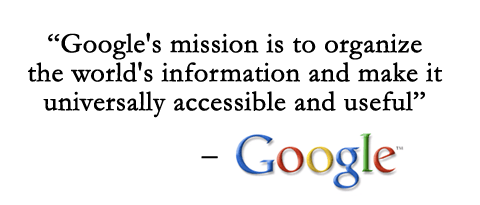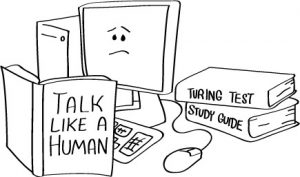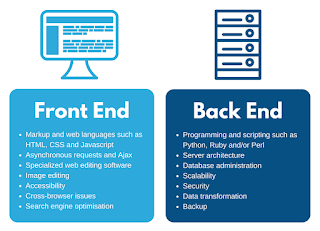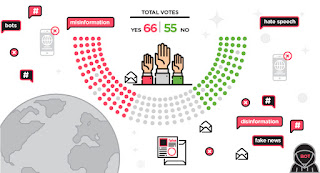Education is a leaky, old boat. It limps forward, year after year, attempting to do a difficult thing: raise everyone who darkens its doors toward their intellectual potential. It does this with as few resources as it possibly can. Students in the system span the full range of human society, from future astronauts and doctors to serial killers and drug addicts. With the same simplistic, systemic process, education attempts to meet each of them where they are, which can range from years ahead of the curve with loving support from parents, to intellectually challenged and abused children who don’t know what a safe home is. Those two students often wind up in the same class.
To further complicate things, education is run by politicians. These are people whose first inclination is to ensure their own re-election, regardless of how cruel they need to be to satisfy their angry, ignorant, myopic supporters. The education system knows nothing of long term planning or sustainability, which is why it struggles to keep up with societal shifts such as the evolution of technology. Depending on the vagaries of Canada’s outdated first past the post system, a small minority of Canadians can vote in a ‘majority’ government that has four years of free reign with no checks or balances. Plans and programs can disappear in a single election cycle to be replaced by whatever self-serving project the sitting government decides suits it. The Ministry of Education isn’t really about education, it’s about governments exercising unchecked power.
The rubber hits the road in the classroom where teachers attempt to ply their trade under seemingly random changes of management. As a teacher your goal isn’t to cherry-pick the best students and forget the rest, as in business, though that is what many teachers fall back on due to a lack of training or support in our changeable system. The true goal of public education is to have everyone finish their year better than they started it. That alone would be a difficult ask, but in the lost world of public education teachers also have to force students with a wide range of socio-economic and developmental disparities through standardized testing that demands all students of a certain age, regardless of their personal circumstances, perform similarly in reading and mathematics. Privilege is systemically rewarded in public education.
A worthy long term pedagogical goal would be to ensure every student ends the year better intellectually equipped than they began it, and a viable graduation requirement would be for every student to have attained a proximity to their own specific developmental potential, but none of this is the case. Grades are a fiction designed to compare students to an average that doesn’t exist. If every graduate was operating close to their specific potential, society would benefit greatly and we wouldn’t wound students by educating them as we do. Instead, as in society at large, the education system rewards privilege and exacerbates social inequities on a massive and meaningless scale. No wonder so many students and the adults they become hate the education system, but in fairness, our education system is merely a reflection of the shittiest aspects of our society.
At times of stress, such as during a pandemic, education’s low resolution, stigmatizing approach to learning is cast into a clear focus. When suddenly asked to learn from home, it becomes apparent that many children don’t live in home that can or does focus on maximizing their potential. The most obvious examples are socio-economic in nature. You can’t be a student in a home where you have neither the space nor the resources to use the digital tools needed to continue your learning remotely, but these students never had these means of enrichment, though they’re expected to be fluent in them. Academic students go home to stable, literate and enriched home lives, applied and essential students go home to intellectual deserts. This isn’t always socio-economically driven. A student can be just as intellectually impoverished when their parents decide to buy them game systems and toys instead of multi-purpose computers and other tools capable of something other than mindless entertainment.
The stigmatizing nature of our education system also produces its worst outcome: school is something that is done to students against their will. They are passive victims of their own education – a dehumanizing process that they are dragged through unwilling and something they come to despise as a great injustice in their lives. When an emergency prompts remote learning, this culture sees students walking away in droves the moment the Minister of Education tells them marks don’t matter any more. Marks never mattered. These same children, disenfranchised from their own potential, grow up to vote in anti-education politicians who gleefully eviscerate the system further, usually by instituting punitive standardized testing that moves education ever further from its primary duty of helping everyone attain their potential.
Our society is broken in so many ways, and our education systems reflect that dysfunction. Individual pedagogical needs are subsumed by systemic processes driven by the punitive aggregation of individuals into dehumanized, simplistic levels. The system divides children into Brave New Worlds of academic, applied and essential levels of learning based as much how a child’s social circumstances have influenced their intellectual output as what they are actually capable of. If you don’t have to work thirty hours a week to help your single parent keep a roof over your head, you have much more time to put a shine on your school work and enter the rarified academic stream. That also happens to be the stream that the instructor at the front of the class wants to teach.
Imagine an education system that is considered an essential service and exists to meet a rigorous set of requirements based on scientifically demanding best pedagogical practices. This system exists beyond the reach of callous politicians and the angry, bitter people who put them in power. Its only function is to raise everyone in it year over year and graduate them as close to their human potential as possible. This imaginary system does this as safely and progressively as it possibly can. It embraces change and works continually to develop the science of pedagogy. Adults working in the system are held to the highest standards and success in it takes more a privileged home life. Imagine an education system blind to privilege that can see a student’s potential clearly, wouldn’t that be something?
By refocusing on individual student needs this imaginary education system would radically differentiate itself. The idea of a ‘standard’ classroom would fade away to be replaced by responsive learning spaces that can adapt to individual learning needs. Engagement would play a role in this, but it wouldn’t be the cart-before-the-horse that it is now. Education would come into a high resolution relationship with each student. Standardized testing might also play a role, but only insofar as it helps direct system efficacy, never as a punitive outcome for the students taking it, or the teachers who have to administer it. Imagine testing that helps a compassionate system recognize the need for more support in a low-literacy neighborhood instead of one that just lowers real estate values.
The backwards class size arguments made by people who know nothing of the science of instruction would also disappear in this system. There are class sizes that produce optimal learning outcomes. That is how big classes would be. In a class where a number of students have learning challenges, the class size would be smaller. In a class full of capable senior students, classes would be bigger. The idea of a simplistic cap that ignores who is in the room would no longer exist.
Graduation would fall out of its yearly lock-step. Instead of low-resolution grading and group assessments leading to a fictionalized grades, students would be required to individually demonstrate mastery and would then move on individually. Students may still find themselves in loosely grouped cohorts by age, but their learning is individually analyzed and advancement is based on mastery rather than the year they were born. In this way some students might graduate high school when they are fifteen, while others may do it when they are twenty. The stigma we apply to age and grade would fade away in a system when individual student mastery was what defined advancement.
This fictitious education system as an essential service would be lean. Its main focus would be on student learning. Positions in the system that did not directly support differentiation and personalization of learning would be rare and only filled by peer reviewed experts. The moment such a position had met its goals it would release the teacher back into teaching. People who didn’t want to focus on teaching wouldn’t exist in this lean system. The current bureaucracy in education that insulated privileged people from the harshness of the classroom would blow away. In Canada’s essential education service everyone is in immediate proximity to teaching. Non-teachers are hired to manage administrative details, but these specialists have no financial or administrative control over pedagogical decision making.
Massive secondary education factories would give way to smaller radically localized schools that embrace immediate community connections. The walls of schools would be much more permeable than they are now and the concept of school would seep out into community centres, old age homes and local businesses. Students would work with peers of different ages and these localized schools would be connectivity hubs for their areas, providing digital literacy to both students and the community at large. The majority of students would walk to these localized digital school houses rather than being herded on busses to age specific, remote locations. Canada’s education service would also be a green revolution with a radically reduced school busing system no longer spewing diesel and making our roads less efficient in order to benefit an antiquated, age based school system.
Virtualization means that some teachers would spend the majority of their time providing their expertise through specialized instruction to a wider audience in cyberspace. Augmented and virtual reality would have students and teachers meeting in immersive, meaningful ways not based on geographic proximity. Advanced experiential simulations would offer students learning opportunities that today’s analogue, geographically limited systems can only dream of. Rapid development of these systems and home connectivity provided by radically localized schooling means that remote teaching in a pandemic isn’t a disaster but an opportunity for enrichment. In such a culture of learning, students and teachers wouldn’t find reasons not to learn and teach during a crisis.
The various bureaucracies that have attached themselves to the current school system in order to defend it from politics would fade away in a this essential service that self organizes around individual learning needs and instructional effectiveness. As geographic groupings became less relevant and the benefits of wider networks of distributed expertise came into focus, the service would have an increasingly wider focus, eventually eclipsing national boundaries. At some point in the distant future, a student in Ethiopia would be able to participate in a virtual class happening in Ontario, Canada, all of them operating under the same best pedagogical practices. Education would finally become the great enabler in an interconnected world.
Until public education is unhitched from our increasingly myopic and self-serving political system and placed in a protected category of an essential service focused on maximizing individual potential, it will continue limp along as a broken reflection of a society in distress, augmenting societal inequalities rather than mitigating them and graduating generation after generation alienated from their own potential.
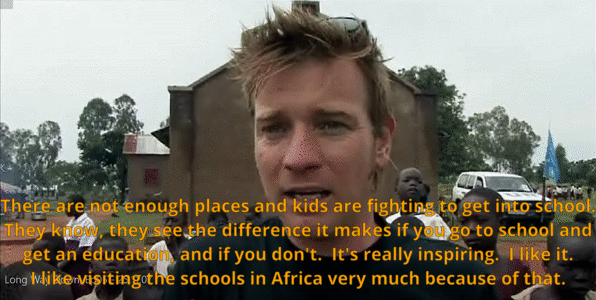 |
| Ewan McGregor after visiting a school in Ethiopia on Long Way Down. In places where education is still recognized as the opportunity it is instead of an expected government service that aggrevates privilege, students approach learning in a very different manner. |
NOTES
The UN describes education as enabling “upward socioeconomic mobility and is a key to escaping poverty”, but it’s the first thing cut to support ‘financial experts’ intentionally destroying the economy in western democracies.
Schools are poorly maintained on radically cut budgets, and classrooms limp along on equally eviscerated budgets (my program is enjoying a budget one-third of what it was five years ago, while trying to serve 25% more students).
Ontario pays less than the Canadian average per student in public education, while also running the largest and most diverse (Ontario takes in as many new Canadians as the rest of the country combined) education system in Canada. Canada itself pays significantly less tax per person than any other G7 country for education and other government services, but produces some of the highest education results in UN testing, beating all those other G7 countries that pay more for less. And still, education is a political scapegoat.
from Blogger https://ift.tt/349EIZp
via IFTTT




